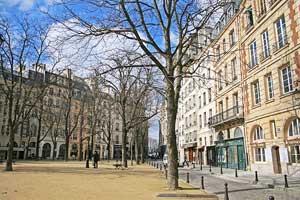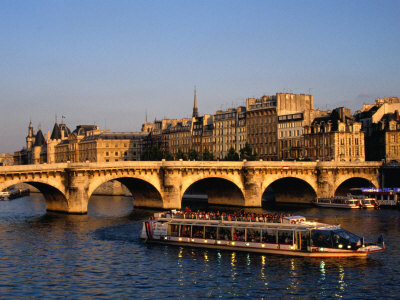It is not hard to see that Ile de la Cité and Ile St-Louis are bursting with history - from the sacred ground of Notre Dame to the sinister history of the Conciergerie, these two islands are a tangible proof of the way Paris has developed through the ages.
To learn more about the founding of Paris and the first settlers on the islands, check out our history pages.
There are so many ancient buildings and monuments on Ile de la Cité that some parts of the island tend to get left out in the story-telling. Keep reading below to learn about the fascinating history of parts of the island that go unnoticed.

Trust the Parisian surrealists to nickname Place Dauphine "le sexe de Paris" because of its suggestive V shape.
In reality it is much more proper and respectable than that. This quaint little triangular-shaped square was finished in 1609 when the Place des Vosges was still under construction and was built by Henri IV in honor of his son, the Dauphin of France and the future Louis XIII.
Achille du Harlay was entrusted with the task of building thirty-two houses adhering to a single plan, which he did admirably, and it is this symmetry that makes the Place Dauphine one of the most beautiful and harmonious in Paris.
You enter the square through a kind of gateway that means that you will find almost no traffic in the square and so makes it almost a tranquil island, within the island of Ile de la Cité.
The Place Dauphine is probably the closest you can get to the Paris of everyone's imagination: cobbled streets framing a lush park populated with benches waiting for the avid reader, old men grumbling over petanque and quintessential cafés serving great food on iron tables on the pavement.
Tourists don't seem to discover this place very much, much to their loss.
Ironic that one of the most idyllic, and perhaps authentic, Parisian scenes can be found hidden in amongst the biggest tourist attractions in the city.

Le Pont Neuf (meaning "The New Bridge") is the oldest bridge in Paris - apparently no one had the foresight to see that the chosen name might become slightly outdated.
The construction of Pont Neuf was talked about for a long time (Henri II was asked to build a new bridge in 1550 but couldn't afford it) and then even when it was decided on, it was a slow and painful process.
Henri III made the decision to build the bridge in 1577 and managed to lay the first stone in 1578. It took another nine years to complete.
From 1588 the Wars of Religion got in the way, delaying the building of Pont Neuf further but finally construction resumed 10 years later in 1599. Finally the bridge (not so new after all) was triumphantly inaugurated in 1607 by Henri IV.
So three monarchs and 57 years later, the Parisians finally had their "new" bridge.
There is a fantastic bronze equestrian statue of King Henri IV in the area. It has quite some interesting history. It was destroyed in 1792 during the French Revolution but during the restoration the Bourbon monarchy thought it right to rebuild it.
The new sculptor reportedly concealed four boxes inside the statue containing a history of the life of Henry IV, a 17th-century parchment certifying the original statue, a document describing how the new statue was commissioned, and a list of people who contributed to a public subscription.